Disciple: Walking the Path
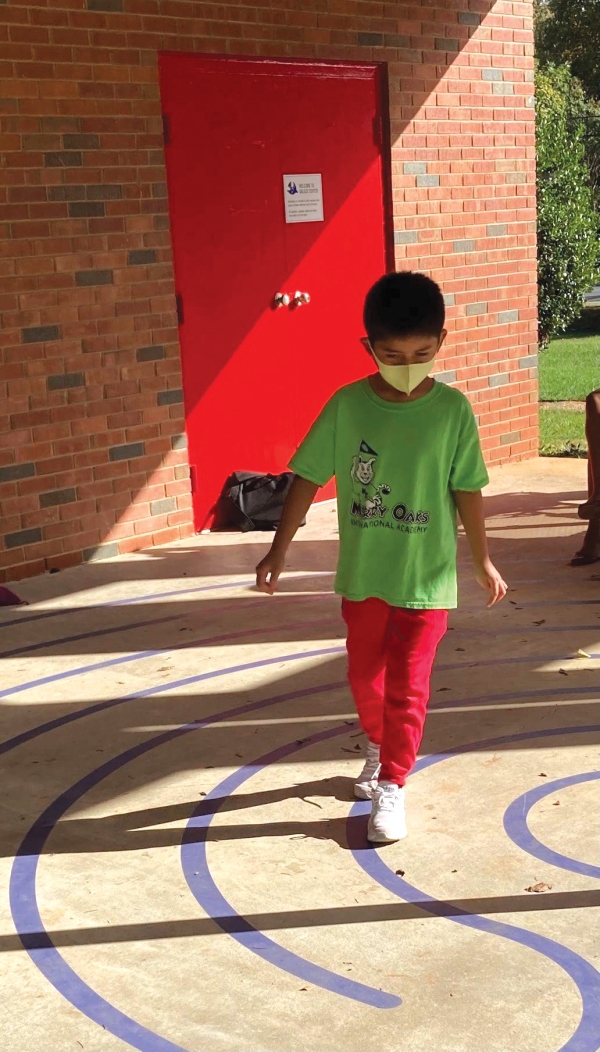
Labyrinths provide spiritual refuge and community outreach
By Summerlee Walter
Originally, labyrinths were places of myth, originating in the ancient story of Daedalus building an impenetrable maze for King Minos to entrap his minotaur stepson. In modern parlance, although “labyrinth” is often used interchangeably with “maze,” the two are not the same thing. Unlike its mythical predecessor, a modern labyrinth is unicursal, with one path leading in and out. There is no branching, no decision to make, and, critically, no possibility for mistakes. Unlike in a maze, a walker who enters a labyrinth follows a single path, a journey that allows the mind to wander—or to focus on meditation and prayer.
[Image: A child from the Learning Vine, a remote learning site for 24 children Galilee Ministries of East Charlotte hosted in partnership with the Greater Enrichment Program and Charlotte Mecklenburg Schools during fall 2020, walks the labyrinth at the Galilee Center. Photo by Vickie Traynum]
Labyrinths have existed across cultures for millennia, from ancient Egyptian funerary complexes to millennia-old stone structures on an island chain in the sea northwest of Russia, and people of all backgrounds and faith traditions engage with their modern iterations in a variety of ways, walking them in accordance with chakras, the cycles of the moon or a practice of meditative prayer. In the Christian tradition, labyrinths flourished in cathedrals built during the late Middle Ages, beginning to appear in churches in northern Italy during the early 12th century. The most famous example of a Christian labyrinth is the one inlaid in the floor of Chartres Cathedral, 50 miles southwest of Paris. It is unclear exactly how labyrinths figured into the worship life of cathedrals, although a common assumption is they were meant to mirror pilgrimages for people who could not journey to holy sites.
The modern resurgence in the labyrinth’s popularity began in the late 1980s, when the Rev. Dr. Lauren Artress visited the Chartres Cathedral, moved the chairs covering the labyrinth and walked it. Moved by the experience, she sought to bring labyrinths to the American consciousness. In 1995, she incorporated the nonprofit Verditas, “dedicated to inspiring personal and planetary change and renewal through the labyrinth experience.” She was successful; the World-Wide Labyrinth Locator currently lists more than 5,850 labyrinths in more than 85 different countries around the world. While some of them are certainly ancient creations, many more are located at modern churches, health facilities and spas. Searching North Carolina alone returns 164 entries, including several within the Diocese of North Carolina.
THE POWER OF LABYRINTHS
After her husband, a labyrinth devotee, passed away on the first Sunday of Advent in 2015, Toni Robinson signed up for Veriditas’ first East Coast summer school, held at Kanuga, in the summer of 2016. Although she’d had experiences with the labyrinth as a result of her husband’s passion—and a long-ago college visit to the Chartres Cathedral—she was, admittedly, a skeptic. After meeting Artress at Grace Cathedral, San Francisco, in March 2017 for a weekend workshop, Robinson came away with a deep appreciation of labyrinths. She is now a Veriditas Certified Labyrinth Facilitator, and that skepticism is far behind her. She recalls the precise date of her most recent transformative labyrinth experience: April 21, 2021, at the labyrinth at St. Paul’s, Wilkesboro, in the Diocese of Western Carolina.
“It was a windy day; it was an ugly day—enthusiastically wintry, let’s put it that way. I was in the midst of the labyrinth, and it was as if a lightning bolt struck me. I had to go sit down. All I know is I was rewired that day.”
Before the COVID-19 pandemic, Robinson, a member of St. John’s, Charlotte, volunteered once per week at the front desk of Galilee Ministries of East Charlotte and got to know everyone passing through the building. It became known around the ministry she was working on building a legacy labyrinth at St. John’s in honor of her husband, and, when Toni Hagerman, then the executive director of Galilee, heard the builder was visiting Charlotte in early spring 2019, she invited him to visit the ministry. The builder gave a quote, and, within a few weeks, Hagerman had found the funds to paint a labyrinth on the concrete patio next to the memorial garden outside of the Galilee Center. The painting was completed on April 1, just as the pandemic was beginning.
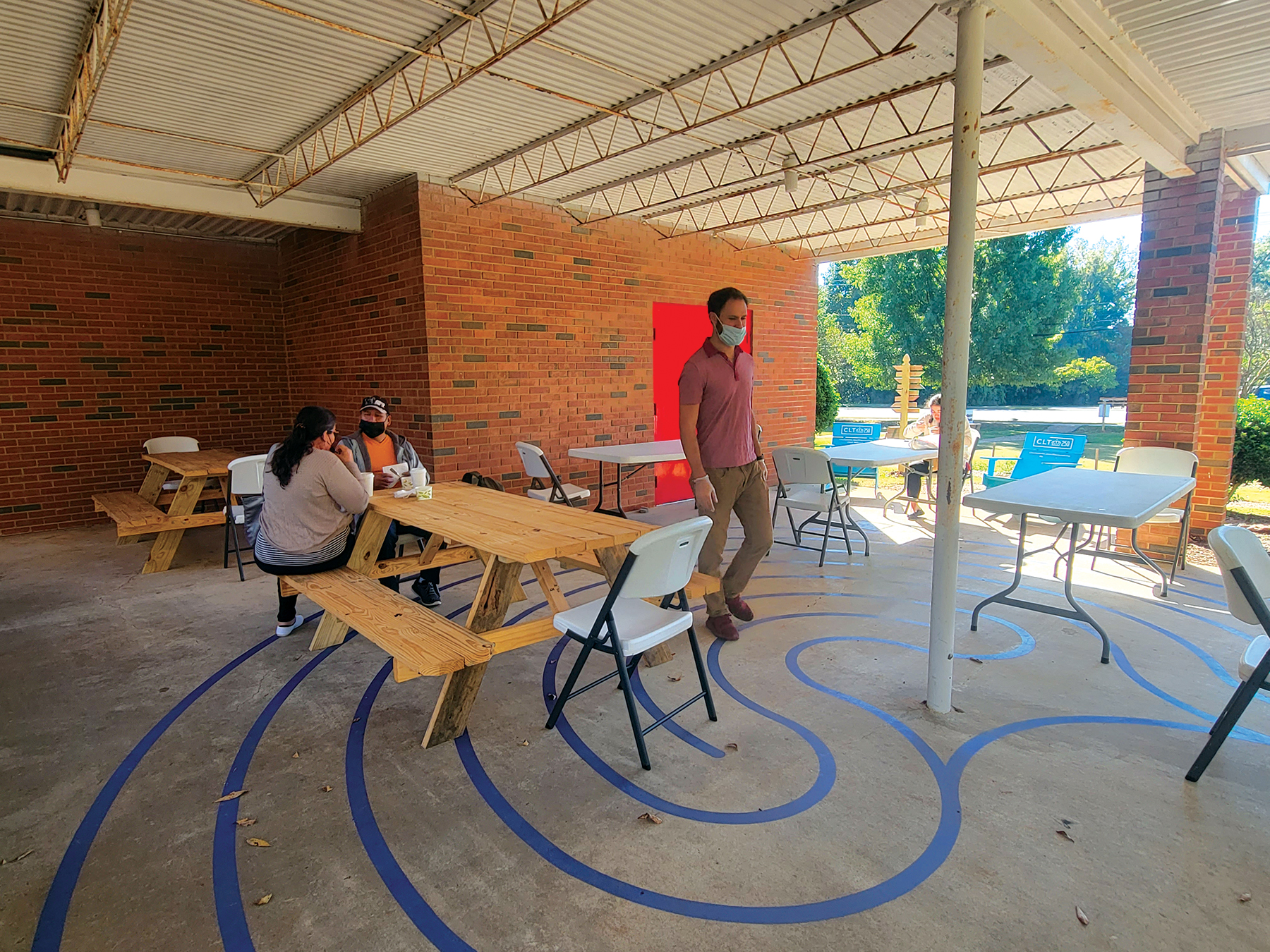
“However you show up that day is fine; you are where you are supposed to be,” Robinson said. “If you need to relax, if you wish to bring a mantra, if you wish to bring Scripture, [you can], but, if you’ve never walked, just hit a pace that works for you and think about your breathing. Typically, it takes three times to walk a labyrinth before one’s comfortable with it.
[Image: The labyrinth at Galilee Ministries provides a different type of community hospitality, as it also serves as an outdoor dining room for the biweekly community meal. Photo by Vickie Traynum]
“I really go easy, and, of all the people I’ve taken, never has anyone left and said, ‘Well I noticed nothing.’ At the very least, everyone says, ‘I’m much more relaxed,’ which is the whole point of walking meditation: It is to invite one to pause for a little time, quiet all the chatter and connect by walking.”
The Rev. Robert Black, rector of St. Luke’s, Salisbury, also appreciates the ease with which people can begin using labyrinths as a prayer practice.
“They give you enough to do that the distractions sort of fade away,” he explained. “If I tell you to sit in a chair and just think about God, then you think about the grocery list and everything else. But if there is a small task to do, by having that, it gives you enough to focus on, but it’s not complicated. A rosary or an icon or a labyrinth is great because it’s just complex enough that it lets your brain have that distraction that it needs but not so complicated that you can’t focus on the prayer and just being.”
Libby Haile, a Veriditas Certified Labyrinth Facilitator at Holy Trinity, Greensboro, agrees. “In any labyrinth, it’s generally considered to be appropriate to have a fairly narrow path instead of a really wide one, and I think one of the advantages of it is, for people like me who aren’t really good at sitting down and meditating, part of your brain has to concentrate on keeping you on the path, and that really frees you up to receive what you need to receive at any given time.
“It takes concentration to follow the path, but it doesn’t take a lot of thinking in the sense of decision-making or wondering if you’re doing it right.”
The labyrinth at St. Patrick’s, Mooresville, is situated in an ideal spot for such times of peace, quiet and just being. Located at the end of a short nature trail by the woods next to the church, the center of the labyrinth sits under a break in the leafy canopy surrounding the path. It was here that parishioner and Veriditas Certified Labyrinth Facilitator Kat Sykes had her own powerful labyrinth experience.
“I had an absolutely incredible walk one day,” she said. “It was raining and dreary, and I was really sad. It was right at the beginning of COVID, and we had lost a parishioner’s son to addiction. Another friend’s son had experienced the same thing…. Something told me just go to the middle [of the labyrinth], look up and take a picture. And I did.
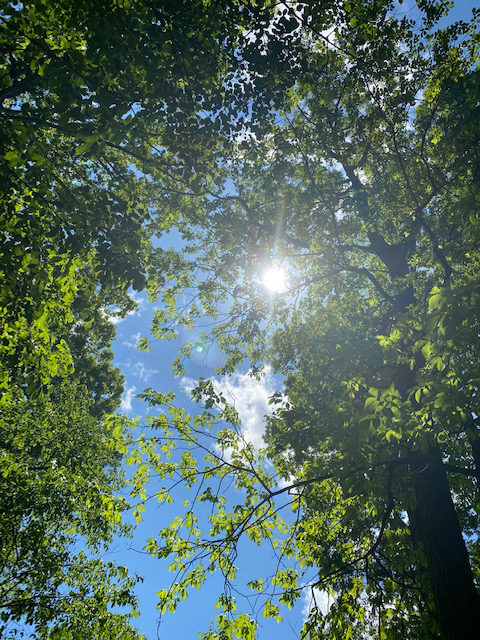
“I walked the labyrinth, and I got to the middle, and when I looked up, it was a beautiful blue sky—all of a sudden the rain had stopped, the sun was shining—and I just got this really powerful message that said, ‘Tell our parents we’re okay.’ And it just, it rocked my world. That was one of several really sacred times for me in that space.”
Black has a similar story to share about the effect a labyrinth can have on someone. A community member who had attended an event held on St. Luke’s outdoor labyrinth donated an indoor canvas labyrinth to the church as a way of sharing the practice after walking labyrinths helped her heal after losing her child.
“Walking is a human thing that humans do,” Black said. “People walk their neighborhoods all the time for exercise but also for companionship, people do pilgrimages, so it’s just an interesting way to have a spiritual focus on the human proclivity to walk. We march when we have a cause, and so [labyrinths] tap into that instinct we have to walk and turns it toward God.”
[Image: The view from the center of the labyrinth at St. Patrick’s on the day Kat Sykes had her emotional experience. Photo by Kat Sykes]
HOW TO BUILD A LABYRINTH
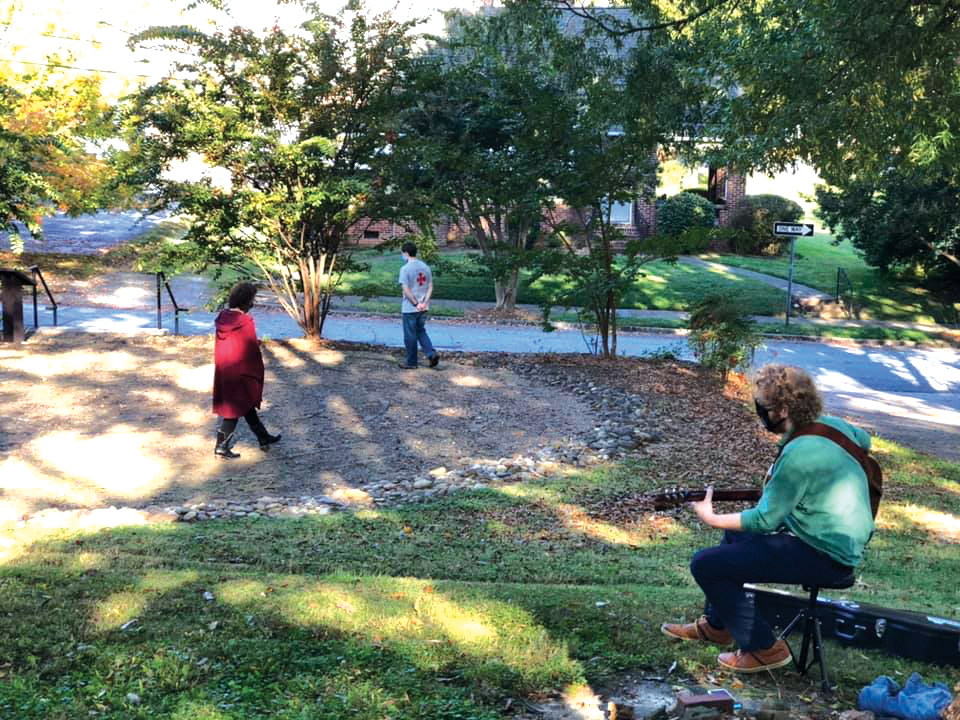
Like many churches in the Diocese, St. Luke’s has a labyrinth constructed as an Eagle Scout project in 2015. Located on land owned by the city at the site of a former community garden, the seven-circuit labyrinth is used both by members of St. Luke’s for retreats and as a community offering. Early during the COVID-19 pandemic, St. Luke’s invited its neighbors to come and walk the labyrinth while a guitarist played so people would have something to do. A permanent sign on-site also provides information about how to use the labyrinth.
[Image: Early during the COVID-19 pandemic, St. Luke’s, Salisbury, hosted two guided community walks on its labyrinth. A guitarist accompanied the walks. Photo by Caroline Stephenson]
St. Patrick’s also has its labyrinth thanks to teenage ingenuity. When the son of the former youth minister needed an idea for a high school math project, his mother suggested he figure out the logistics of building a labyrinth. So he did.
“He got a hundred, and we got a labyrinth,” Kat Sykes explained. Over time, however, rocks shifted or were moved, so a later member of the congregation cemented the stones into place for his Eagle Scout project. As time took its toll on that iteration of the labyrinth, another St. Patrick’s teen built the current seven-circuit patterned labyrinth for his Eagle Scout project.
The outdoor labyrinth at Holy Trinity, Greensboro, came about differently, growing out of the congregation’s experience with an indoor canvas labyrinth parishioners walked monthly for years after a visit from Artress in 1995. The permanent outdoor stone labyrinth, composed of nine circuits, is set within the columbarium, with the 28 lunation, or semicircular decorative edges, actually integrated into the columbarium.
GETTING CREATIVE
The Labyrinth Keepers at Holy Trinity host several walks each year, marking the autumnal and vernal equinoxes; Palm Sunday, Holy Week and Easter; All Saints’ Sunday; and the church’s annual memorial service for those who have died, held each December. One year, the church attempted a walk on the summer solstice, but the June heat made that a one-time event.
“There’s only one major rule about walking the labyrinth, and that is there’s no wrong way to do it,” Haile explained. At Holy Trinity, walkers have the option of walking straight in and back out, a process that takes about 25-30 minutes, or of stopping at one of the benches in the center of the labyrinth to pray.
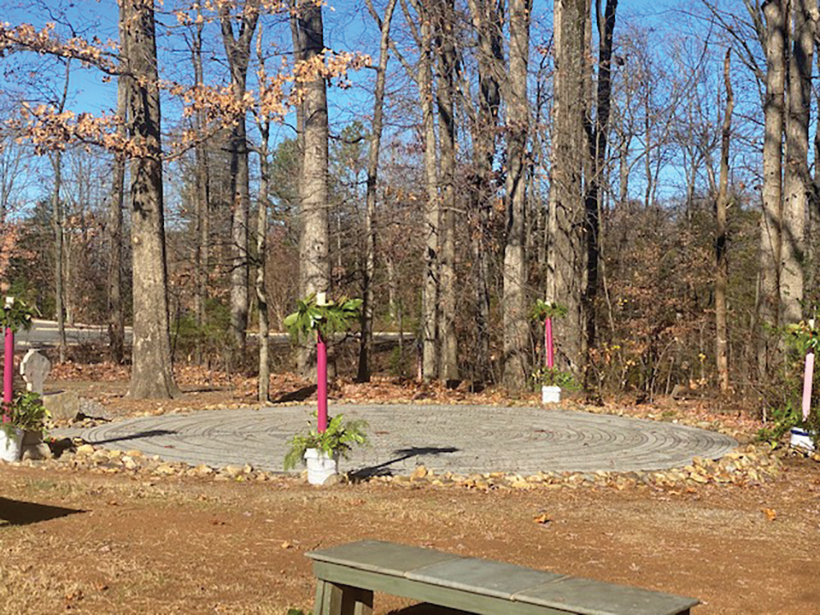
St. Patrick’s also makes good use of its labyrinth during Advent and Lent. December sees the labyrinth transform into a giant Advent wreath with four large, purple, battery-operated candles constructed of PVC pipes in the corners. During Lent 2021, volunteers placed at the beginning of the labyrinth a box containing Lenten devotions reflecting on the pandemic and journaling materials. People were invited to read the devotions and contribute their own thoughts. The church also set up Stations of the Cross along the path. Currently, St. Patrick’s is trying to promote use of the labyrinth by the nearby hospital and other medical practitioners.
[Image: The labyrinth at St. Patrick's transforms into an Advent wreath in December. Photo by Kat Sykes]
St. Ambrose, Raleigh, also sees its new labyrinth as a resource for the wider community. Built as part of the $24,000 Creation Care Grant from The Episcopal Church the church received in July 2021 to fund their proposed project, “The Healing Pod: Resilience and Resurrection Through Education, Spiritual Formation and Healing,” the labyrinth will serve as both a means of spiritual formation and a place that encourages care for mental health. The labyrinth is located under a canopy of trees next to wetlands.
“It was just so calm and serene,” said Hortense Francis, one of the lay leaders behind The Healing Pod. “You can feel the calmness there.”
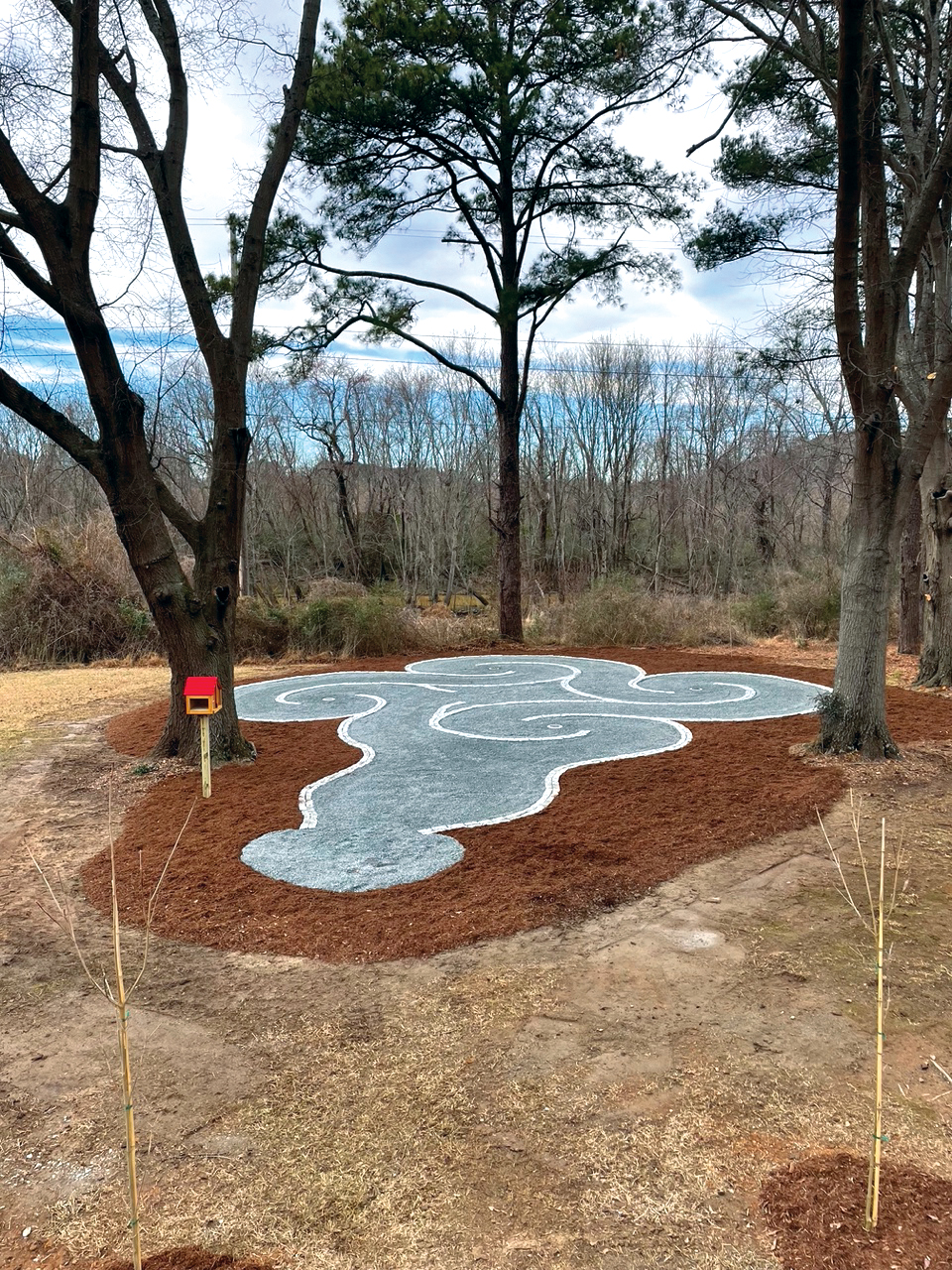
St. Ambrose prioritized making the labyrinth accessible to all. While most labyrinth paths are narrow, both as a practical space consideration and as a way to encourage walkers to pay just enough attention to keep their minds focused and engaged, the labyrinth at St. Ambrose has a nontraditional shape with wide, wheelchair-accessible paths. Signage near the labyrinth will direct walkers to a QR code where they can access prayers designed for use with the labyrinth, and the church is partnering with the Walnut Creek Wetland Park and the Bailey Drive community group to set up a tent with information about the labyrinth during Earth Day activities on April 23. St. Ambrose also plans to center the labyrinth during upcoming Sunday services and to host evening candlelight services as the weather gets warmer.
[Image: The nontraditional shape of the labyrinth at St. Ambrose, Raleigh, makes it both unique and wheelchair accessible. Photo courtesy of St. Ambrose]
St. Ambrose’s concept of using the labyrinth as part of a broader formation and healing program taps into a long tradition of labyrinth as a place of both physical and mental renewal.
“Because of its history—because of its ancient history—because you don’t have to study, you don’t have to read a white paper, you don’t have to say a certain prayer, you can bring whatever yourself is that day, I think it’s a tool that’s worth inviting people to try,” Robinson, the certified labyrinth trainer from Charlotte, said. “In this day and time, with high anxiety levels, and the difficulty of quiet, and the world screaming at each other, now more than ever, I think it is valuable.”
Summerlee Walter is the communications coordinator for the Diocese of North Carolina.
Tags: North Carolina Disciple / Formation
